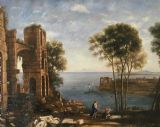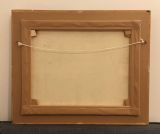Capriccio After Francesco Guardi Mediterranean Landscape Paintings Rome Italy
Price
£1,250
| $1,565 USD | €1,503 EUR
Item Ref
CLC/073/RBC
Description
Impressive classical Roman Empire style vibrant oil on canvas depicting a harbour, ruins, figures and sea, mounted on stretcher within a very decorative swept gilt frame.This painting is a wonderful rendition having good detail and accuracy, a professionally finished work in oil paint on stretched canvas.
These type of scenes known as Capriccio were very popular in Rome from the latter half of the 17th century onwards through the18th and late 19th century period and right up until the mid 20th century.
This example is set within a decorative swept 1960-70ís frame and is an highly atmospheric work produced in a similar manner to many others over the centuries to provide an account of Christ and the centurion, amongst classical ruins and other local denizens.
The combination of the classical ruins and small figures portray the expansiveness of the architecture and scene and demonstrate artistís ability to transcend the talent of perspective.
AFTER FRANCESCO LAZARO GUARDI (1712-1793)
Was a nobleman born in Venice and specialised in little views of the city.He was a collaborator of Canaletto when he was in his 40ís and became later very popular running a large studio of his own.
He is considered to be among the last practitioners of the classic Venetian School of painting He trained both his younger brother Nicolo and his son Giacomo,whose work is well known and who imitated his fatherís style.
Our fine example produced in the 20th century is very much characteristic of Francesco Guardiís Ď capriccio Ď paintings, a genre that became popular in Venice.
The painting creates an imaginary landscape with Roman ruins and small figures involved in a daily activity.
The pictorial rendering of light is particularly elaborate and demonstrates a close style and manner similar to the mastery of the Venetian school artist of the 17th-18th century.
In painting, a capriccio means an architectural fantasy, placing together buildings, archaeological ruins and other architectural elements in fictional and often fantastical combinations.
These paintings may also include staffage (figures). Capriccio falls under the more general term of landscape painting. The term is also used for other artworks with an element of fantasy (as capriccio in music).
This style of painting was introduced in the Renaissance and continued into the Baroque.
CONDITION
Very Good Order Throughout & Ready To Hang.
FRAMED MEASUREMENTS
Height: 20 Inches ( 51cm )
Width : 24 Inches ( 61.5 cm )
Depth: 2 Inches ( 5cm )
DELIVERY
UK Shipping / Packaging £50
Worldwide : £125
TELEPHONE ENQUIRIES: 07765 856171
Ref : CLC/073/RBC
Payments are accepted by Bank Transfer & by Debit / Credit Cards Via the BUY NOW Payment Link Tab shown below each items description.
PAY-PAL Account Holders are welcome. CHEQUES Drawn from UK banks.
Internal Ref: CLC/073/RBC
Dimensions
Height = 51 cm (20")Width = 61.5 cm (24")
Depth = 5 cm (2")
We accept online payments for this item:
BUY NOW with CREDIT CARD or PAYPAL
Email about this item:
SEND EMAIL

















